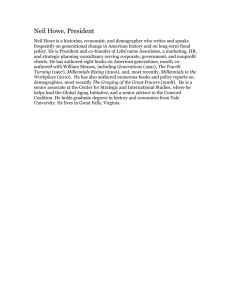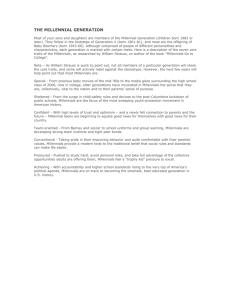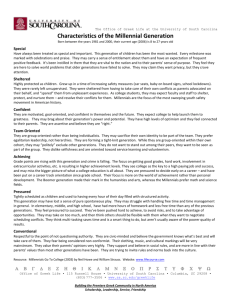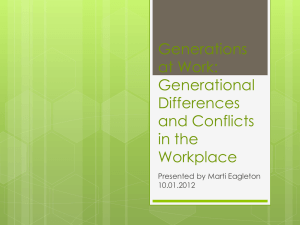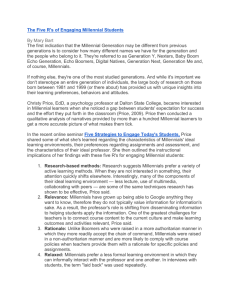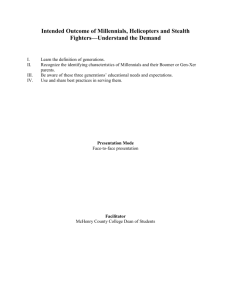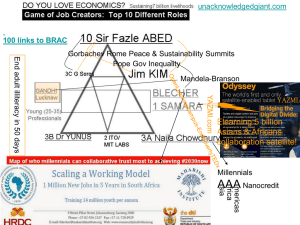To Win Back My Youth encouraging innovation
advertisement
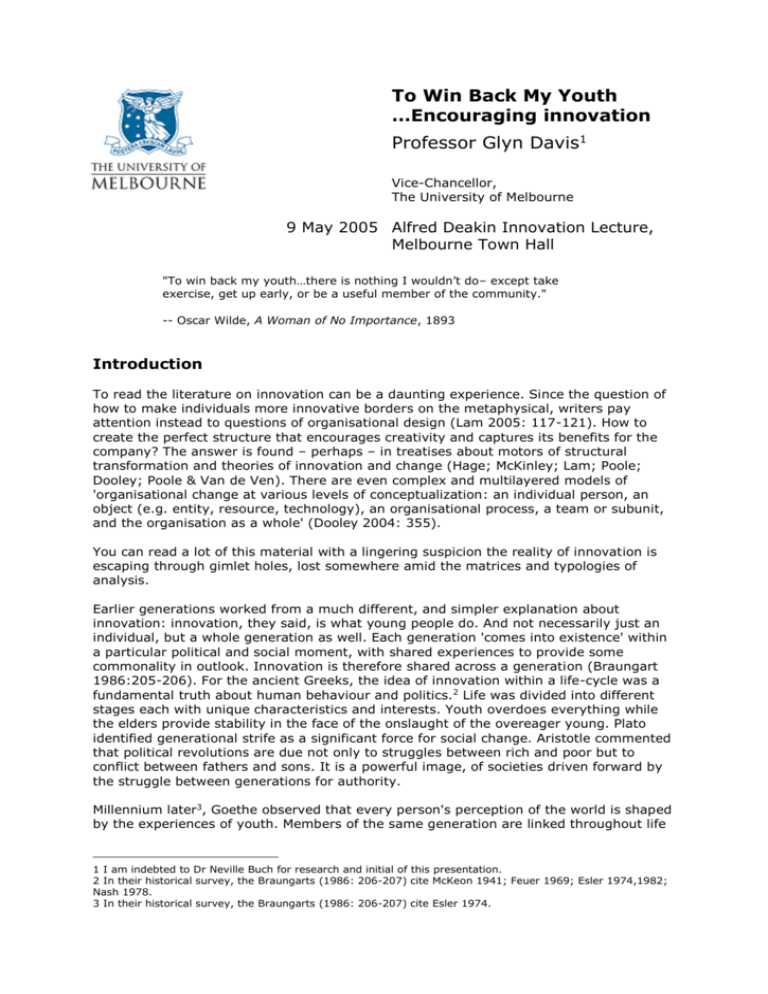
To Win Back My Youth …Encouraging innovation Professor Glyn Davis1 Vice-Chancellor, The University of Melbourne 9 May 2005 Alfred Deakin Innovation Lecture, Melbourne Town Hall "To win back my youth…there is nothing I wouldn’t do– except take exercise, get up early, or be a useful member of the community." -- Oscar Wilde, A Woman of No Importance, 1893 Introduction To read the literature on innovation can be a daunting experience. Since the question of how to make individuals more innovative borders on the metaphysical, writers pay attention instead to questions of organisational design (Lam 2005: 117-121). How to create the perfect structure that encourages creativity and captures its benefits for the company? The answer is found – perhaps – in treatises about motors of structural transformation and theories of innovation and change (Hage; McKinley; Lam; Poole; Dooley; Poole & Van de Ven). There are even complex and multilayered models of 'organisational change at various levels of conceptualization: an individual person, an object (e.g. entity, resource, technology), an organisational process, a team or subunit, and the organisation as a whole' (Dooley 2004: 355). You can read a lot of this material with a lingering suspicion the reality of innovation is escaping through gimlet holes, lost somewhere amid the matrices and typologies of analysis. Earlier generations worked from a much different, and simpler explanation about innovation: innovation, they said, is what young people do. And not necessarily just an individual, but a whole generation as well. Each generation 'comes into existence' within a particular political and social moment, with shared experiences to provide some commonality in outlook. Innovation is therefore shared across a generation (Braungart 1986:205-206). For the ancient Greeks, the idea of innovation within a life-cycle was a fundamental truth about human behaviour and politics.2 Life was divided into different stages each with unique characteristics and interests. Youth overdoes everything while the elders provide stability in the face of the onslaught of the overeager young. Plato identified generational strife as a significant force for social change. Aristotle commented that political revolutions are due not only to struggles between rich and poor but to conflict between fathers and sons. It is a powerful image, of societies driven forward by the struggle between generations for authority. Millennium later3, Goethe observed that every person's perception of the world is shaped by the experiences of youth. Members of the same generation are linked throughout life 1 I am indebted to Dr Neville Buch for research and initial of this presentation. 2 In their historical survey, the Braungarts (1986: 206-207) cite McKeon 1941; Feuer 1969; Esler 1974,1982; Nash 1978. 3 In their historical survey, the Braungarts (1986: 206-207) cite Esler 1974. Professor Glyn Davis To Win Back My Youth ... encouraging innovation by bonds of mutual understanding that set them apart. As a generation grows into maturity, it seeks to transforms the world in its own image. This ancient concept of innovation, therefore, is not abstract, a process outside people. It is instead the outcome of generations – people born into the cultural and historical assumptions of one time but called upon to meet the unfamiliar challenges of another. Innovation results from the press of one generation against another, the demand of the young to break free pushing hard against the accumulated wisdom of the older. In this lecture I want to explore a little the link between youth and generation. Then I want to turn to the unique characters of the generation now arising in our midst – the Millennial Generation, born after 1982. If we want to predict something about change from here – political, social, technological -we need to know something of those who be doing the innovation. Youth and innovation The Book of Joel (chapter 2 verse 28) says that the old dream while the young see visions. As Herbert Moller (1968: 237, 239-260) argued, youth has been the major force in the historical development of the modern world. The Protestant reformers in westcentral Europe were all under 40 years of age at the outbreak of this decisively innovative movement.4 Luther's University of Wittenburg boasted probably the youngest faculty in the history of German universities. Melanchthon was 21 years of age when he took up his professorship. He quickly became acknowledged as the leader of the philosophical faculty though he was younger than many of his students. The younger scholars were Luther's earliest adherents, while the older scholars condemned his ideas. Calvin was 26 years of age when he dedicate his Institutes of the Christian Religion to Francis I. At 32 Zwingli raised his challenge to the old faith. The leaders of the radical wing of Reformation were often younger. Felix Mantz was leader of the Zurich radicals at 25 and executed at 27. Similarly, youth were the leaders and custodians of the nineteenth century nationalist movements.5 The Napoleonic Wars were lead principally by younger men. Napoleon was 35 years of age when crowned Emperor. As nationalism spread across Europe the pattern continued. People over 40 were excluded from Mazzini's organisation, Young Italy. The young led the German Sturm and Drang movement. The three major intellectual leaders of "Young Russia" in the early 1860s were all young. Chernshevesky's political activity ended at age 34 when he was arrested and condemned to forced labour. Dobrolyubov died at 25; Pisarev at 28. Youth is innovative. It is not necessarily progressive. The nationalism of the twentieth century motivated youth, but not always to happy consequences. 6 The First World War was sparked by a member of the Young Bosnians, Gavrilo Princip, who had just completed high school when he assassinated the Archduke Francis Ferdinand. In the elections of the 1930s 4.6 million first-time voters, mostly young people, provided a huge lift in the vote for Adolf Hitler. The subsequent Nazi regime returned the favour with propaganda that stressed a youthful Nordic physique as the embodiment of German virtue. It was a lesson that Mao-Zedong developed even further in the Cultural Revolution of 1966, empowering the young to banish the old. Yet it was not just oppressive societies that celebrated youth and relied on their energy. America has become the quintessential youth culture – in fashion and music, in writing 4 Moller (1968: 237-239) cite Schöffler 1960; Williams 1962. 5 Moller (1968: 240-242) cite Brinton 1957; Hertz 1944; Lampert 1965; Dedijer 1966. 6 Moller (1968: 242-244) cite Dedijer 1966; Kulischer 1948. University of Melbourne www.unimelb.edu.au/speeches/ Page 2 of 7 Professor Glyn Davis To Win Back My Youth ... encouraging innovation and technology. Yet if youth culture is often associated with materialism, it has also generated significant social change. Martin Luther King had just graduated from Boston University, at the age of 26, when he took up the cause of Rosa Parks, so beginning the civil rights movements. He was followed into the fray by young Freedom Riders and an era of violence and youthful Byronic martyrdom, such as the Mississippi Burning murders of three civil rights workers, James Chaney, Andrew Goodman, and Mickey Schwerner. Youth cut off in their prime with unfilled promise of a new order symbolized the era – the Kennedy brothers, Malcolm X, Martin Luther King. Even though the Kennedy administration showed a disturbing penchant for overseas military misadventures, the memory of a youthful but dead JFK has proved an abiding inspiration. Fast forward and the Dead Kennedys becomes one of the most popular and influential American punk bands of the late 1970s and early 1980s. Punk is just one of many musical forms developed – and quickly abandoned – by youth, from rock and roll in the 1950s through all the permutations of style and taste since. Like the struggle of generations in miniature, each new wave in popular music both rejects and pirates the achievements of the past. We distain our heritage yet seek to reconstruct it in our own image – that great need to hear eternal messages restated in a contemporary language. Millennials and innovation So who are the young about to come into positions into maturity, the people now at university or in early career who will shape the world in which we all move? If the clash of generations is the dynamic of innovation, we must locate the emerging cohort in the context of past three or four generations – each defined as 'a society-wide peer group, born over a period roughly the same length as the passage from youth to adulthood, who collectively possess a common persona.' Those born between 1925 and 1942, grandparents or even great-grandparents now, are the 'silent generation', the people shaped by Depression and war. Their children are the boomers – born between 1943 and 1960. Generation X followed, born between 1961 and 1981. The new and rising generation, those born after 1982, have been labelled the 'Millennials' in an influential 2000 study by Neil Howe and William Strauss. Drawing on surveys of the young across America who will each adulthood in the first decade of the twenty-first century, Howe and Strauss described the Millennials as the next great generation, sharing surprising commonalities not with their Gen X uncles and aunts or their boomer parents, but with their Silent Generation grandparents. I've been talking quite a lot about this generation in recent weeks, because they are the cohort who are undergraduates at university, the ever young faces we, the no longer young, see in the hallways and classrooms. In the long run the university, like our broader society, will belong to the Millennials. The innovations they make will shape us all. So what values do they bring to the task? Unfortunately we have only American data, so the match with Australia may not be perfect. But given America's dominant global position, the Millennials from the United States will go on having a very large say about the world. Howe and Strauss identify seven core traits for this Millennial generation – they, or you depending on age, are special, sheltered, confident, team-oriented, conventional, pressured, and achieving. Parents have inculcated in Millennials the sense that they are special, collectively vital to the nation and to their parents' sense of purpose. Howe and Strauss cite a 1998 survey in which more than half of all adults (a record share) said that 'getting kids off to the right start' ought to be America's top priority. Evidence supports the finding that University of Melbourne www.unimelb.edu.au/speeches/ Page 3 of 7 Professor Glyn Davis To Win Back My Youth ... encouraging innovation millennials feel assured about their place in the world, and are blessed with greater confidence than previous generations. One marker is the striking fall in youth suicide. This began with Generation X and continues falling under the Millennials. Youth suicide is now at a rate per hundred thousand people less than that afflicting the boomers. Though the numbers are too high still, Millennials are less likely to suicide than any preceding generation. Perhaps Millennials feel safe. They should – their generation is the focus of the most sweeping youth-protection movement in American history, from the surge in child-safety rules and devices to the post-Columbine lockdown of public schools. Throughout the '90s, Boomers and Generation Xers tightened the security perimeters around their children. Worried parents became avid consumers for a child-proofing industry that sold everything from stove-knob covers to safety mirrors. One sign of parental concern was the falling employment rate of 15 year old Americans during the school year. Parents don't want their kids in strange workplaces or away from home. Millennials report high levels of trust and optimism and a newly felt connection to parents and to the future. As late as 1994, 70 percent of Generation X, 13-to 17-yearolds at that time, said it's 'harder' to grow up now than in their parents' time. By 1999 the equivalent figures for Millennials had dropped to 43 percent. Millennial teens are optimistic not only about their futures, but about their eventual children as well. They see the future with a far longer view than their parents did. More than half of all Millennial teens agree that 'people my age should be optimistic about their chances of having a good job.' More than four in five teens believe they will be financially more successful than their parents—a percentage that rose sharply during the 1990s. The share of teens who define success as 'being able to give my children better opportunities than I had' has reached an all-time high. Similar 'positive and confident' findings were found in a survey of 18-19 years entering higher education in their attitudes towards rasing a family, having a meaningful philosophy, and owning a successful business. The prosperity of the 1990s and beyond has produced an enduring sunny outlook. The pattern appears similar in Australia. In 2001 just over 80 percent of young people reported that were 'delighted', 'pleased' or 'mostly satisfied' with their quality of life, while only 4% saw their lives as 'unsatisfactory', 'unhappy' or 'terrible'. Interestingly, a greater proportion of young people who were not satisfied with their quality of life had not completed schooling beyond Year 9. Children don't drop out of school because they are made unhappy by school. Children drop out of school because they're already unhappy – and the stay unhappy. According to Howe and Strauss, Millennials are developing strong team instincts and tight peer bonds. Howe and Strauss asked Millennials to identify 'the major causes' of America's problems. The seven most popular answers all relate to what Millennials perceive as excessive adult individualism. Reason number one is 'selfishness, people not thinking of the rights of others.' Reason number two is 'people who don't respect the law and the authorities.' Reason number four is 'lack of parental discipline of children and teens.' Very few Boomer teens would have argued for more strict parents, and more peer pressure – but peer pressure harnessed for good through student juries, peer grading, to enforce rules better. Howe and Strauss indicate that Millennials are taking pride in their improving behaviour and are quite comfortable with their parents' values. They believe that social rules and standards can make life easier. And, in important respects, they are more inclined to follow those rules. The United States has recorded a significant decline in substance abuse reported for 12-17 year olds, following a significant decline of cannabis use among the previous Generation X. A second indicator that Millennials seek to a more conventional life is the declining rate of rates of teenage pregnancy, abortion, and births. University of Melbourne www.unimelb.edu.au/speeches/ Page 4 of 7 Professor Glyn Davis To Win Back My Youth ... encouraging innovation Howe and Strauss report Millennials feeling pressure to excel, pushed to study hard, avoid personal risks, and take full advantage of the collective opportunities adults are offering. Technology, with its constant demands for response to phone calls, email and instant messages, is putting additional demands on a Millennial's time. Constant pressure keeps Millennials moving, busy, and purposeful. As evidence, Howe and Strauss point to an increase in reports of 18-19 years who indicate they are frequently overwhelmed and seek personal counselling. Yet at the same time there is a decrease in those who report being frequently depressed. Millennials are pressured but they're confident. They can live with stress. Howe and Strauss claim that Millennials are on track to becoming the smartest, besteducated generation in history of the United States. They report a majority of today's high-school students have detailed five-year and ten-year plans for their future. Most have given serious thought to college financing, degrees, salaries, and employment trends. These kids are focused. Television time has decreased 13 percent while study time has increased 58 percent. Focused and determined – a 2000 survey shows 97 percent of Millennials believe in their generation's lifelong ability to improve technology, 77 percent in the ability to improve race relations, and 55 percent in an ability to improve the economy. Implications for the future innovation So the boomer generation has produced a miracle – a generation to follow that is better adjusted, more balanced, happier than their parents. A generation that is the best educated in world history, adept with technology, skilled at setting personal goals. A generation that rejects selfishness and celebrates self-discipline. A generation that shares a concern about the environment and political accountability, with a commitment to longer term planning. Will the benefits of a secure upbringing and a boundless optimism produce the most innovative generation in history? There are lots of reasons to think so. The ability of the Millennials to take new technology such as peer to peer programs on the Internet and use it to run conversations over vast networks of contacts has been impressive indeed. To achieve their lofty ambitions, the Millennials have all the skills and opportunities necessary. On this view, we can expect current students to flood into the workplace over the next years, brilliantly positioned to create more innovative organisations. And yet there is another ancient wisdom that might come into play – a darker view that says invention follows necessity, that without misfortune it is hard to be creative. Millennials are privileged, and therefore personally conservative. They have grown up amid prosperity, which does not encourage a great desire for change. So Millennials are not pressing their elders for change, and therefore forging a new world. Where is the ferment described by Plato, the struggle between generations? Perhaps it takes harder times to spark conflict and so drive change. To generation tension must we add adversity to arrive at innovation? To quote Harry Lime from The Third Man, "In Italy for 30 years under the Borgias they had warfare, terror, murder and bloodshed, but they produced Michelangelo, Leonardo da Vinci and the Renaissance. In Switzerland, they had brotherly love -they had 500 years of democracy and peace, and what did that produce? The cuckoo clock." University of Melbourne www.unimelb.edu.au/speeches/ Page 5 of 7 Professor Glyn Davis To Win Back My Youth ... encouraging innovation On this view our Millennials have everything they need to innovate – except a reason. I expect life will provide one soon enough. References Braungart, Richard G., and Margaret M. Braungart. 1986. Life-Course and Generational Politics. Annual Review of Sociology 12, 205-231. Brinton, Crane. 1957. The Anatomy of Revolution. New York: Vintage Books. Cameron, Kim S., David Bright, and Arran Caza. 2004. Exploring the Relationships Between Organizational Virtuousness and Performance. The American Behavioral Scientist 47, no. 6:766. Dedijer, Vladimir. 1966. The Road to Sarajevo. New York: Simon & Schuster. Dooley, Kevin J. 2004. Complexity Science Models of Organizational Change and Innovation in Handbook of Organizational Change and Innovation (edited by Marshall Scott Poole, Andrew H. Van de Ven). New York: Oxford University Press. Drucker, Peter. 1985. Innovation and Entrepreneurship. Oxford: ButterworthHeinemann. Esler, A. ed. 1974. The Youth Revolution. Lexington: Heath. Esler, A. 1982. Generations in History: An Introduction to the Concept. Williamsburg: Esler. Feuer, L.S. 1969. The Conflict of Generations. New York: Basic Friedman, Batya. 1997. Social Judgments and Technological Innovation: Adolescents' Understanding of Property, Privacy, and Electronic Information. Computers in Human Behavior 13, no. 3:327-351. Hage, J. T. 1999. Organizational Innovation and Organizational Change. Annual Review of Sociology 25, 597-622. Hetz, Frederick. 1944. Nationality in History and Politics. London: Kegan Paul. Howe, Neil and William Strauss. 2000. Millennials Rising: The Next Great Generation. New York: Random Books. Howe, Neil and William Strauss. 2003. Millennials Go to College: Strategies for a New Generation on Campus. American Association of Collegiate Registrars and Admissions Officers. University of Melbourne www.unimelb.edu.au/speeches/ Page 6 of 7 Professor Glyn Davis To Win Back My Youth ... encouraging innovation Kulischer, Eugene M. 1948. Europe on the Move: War and Population Changes, 19171947. New York: Columbia Lam, Alice. 2005. Organizational Innovation in The Oxford Handbook of Innovation (edited by Jan Fagerberg, David C. Mowery, Richard R. Nelson). Oxford: Oxford University Press. Lampert, E. 1965. Sons Against Fathers: Studies in Russian Radicalism and Revolution. Oxford: Clarendon Press. McKeon, R. ed. 1941. The Basic Works of Aristotle. New York: Random House McKinley, William. 1993. Organizational Decline and Adaptation: Theoretical Controversies: Organization Science. Focused Issue: Organizational Decline and Adaptation: Theoretical Controversies Vol: 4 No: 1, Focused Issue: Organizational Decline and Adaptation: Theoretical Controversies Series: 1-9. Moller, Herbert. 1968. Youth as a Force in the Modern World FT: Comparative Studies in Society and History 10, no. 3:237-260. Nash, L.L. 1978. Concepts of Existence: Greek Origins of Generational Thought. Daedalus. 107: 1-21. Poole, Marshall S. 2004. Central Issues in the Study of Change and Innovation in Handbook of Organizational Change and Innovation (edited by Marshall Scott Poole, Andrew H. Van de Ven). New York: Oxford University Press. Poole, Marshall S., and Andrew H. Van de Ven 2004. Theories of Organizational Change and Innovation Processes in Handbook of Organizational Change and Innovation (edited by Marshall Scott Poole, Andrew H. Van de Ven). New York: Oxford University Press. Schöffler, Herbert 1960. Wirkungen der Reformation. Frankfurt: Klostermann. Williams, George. H. 1962. The Radical Reformation. Philadelphia: Westminster Press. University of Melbourne www.unimelb.edu.au/speeches/ Page 7 of 7
